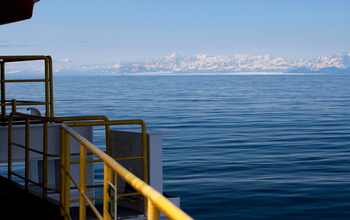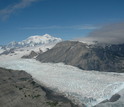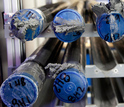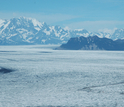Hola amigos: A VUELO DE UN QUINDE EL BLOG., Por primera vez, los investigadores han tratado de medir todo el material que entran y salen de una cadena montañosa a lo largo de más de un millón de años.
Han descubierto que la erosión causada por la glaciación durante las edades de hielo puede, en las circunstancias adecuadas, desgastar a las montañas más rápido que la tectónica de placas pueden construirlos.
El estudio, realizado por Integrated Océano Drilling Program (IODP) investigadores y liderado por científicos de la Universidad de Texas en Austin, la Universidad de Florida y la Universidad Estatal de Oregon, añade una idea de un debate de larga data sobre el equilibrio del clima y de las fuerzas tectónicas que la influencia formación de montañas.
Han descubierto que la erosión causada por la glaciación durante las edades de hielo puede, en las circunstancias adecuadas, desgastar a las montañas más rápido que la tectónica de placas pueden construirlos.
El estudio, realizado por Integrated Océano Drilling Program (IODP) investigadores y liderado por científicos de la Universidad de Texas en Austin, la Universidad de Florida y la Universidad Estatal de Oregon, añade una idea de un debate de larga data sobre el equilibrio del clima y de las fuerzas tectónicas que la influencia formación de montañas.
More information............
Erosion caused by glaciation can wear down mountains faster than plate tectonics can form them
 Credit and Larger Version |
For the first time, researchers have attempted to measure all the material leaving and entering a mountain range over the course of more than a million years.
They've discovered that erosion caused by glaciation during ice ages can, in the right circumstances, wear down mountains faster than plate tectonics can build them.
The study, conducted by Integrated Ocean Drilling Program (IODP) researchers and led by scientists from the University of Texas at Austin, the University of Florida and Oregon State University, adds insight into a longstanding debate over the balance of climate and tectonic forces that influence mountain building.
The findings are published today in a paper in the journal Proceedings of the National Academy of Sciences. The study was funded by the National Science Foundation (NSF) and IODP.
The geoscientists studied the St. Elias Mountains on the Alaska coast. They found erosion accelerated sharply about one million years ago when global climate cooling triggered stronger and more persistent ice ages than in times past.
Used seismic equipment, the researchers imaged and mapped a huge fan of sediment deep in the Gulf of Alaska, caused by the erosion of nearby mountains. They then took sediment cores to understand the system.
Earth's systems interconnected
"This study demonstrates how interconnected Earth's systems are, showing that glaciers, tectonics and erosion cannot be considered as independent processes," said Rick Murray, director of NSF's Division of Ocean Sciences. "The results clearly show that extracting sediment cores from a series of single locations allows for insight into global-scale processes."
In IODP Expedition 341, a three-month voyage in 2013, the scientists collected and dated almost 2.5 miles of sediment from the floor of the Gulf of Alaska and the Alaskan continental shelf, revealing millions of years' worth of geological history.
"It turned out that most sediments were younger than we anticipated and most rates of sediment production and thus erosion were higher than we anticipated," said lead paper author Sean Gulick of the University of Texas at Austin's Institute for Geophysics.
Between 1.25 million and 700,000 thousand years ago, Earth experienced a climate change known as the mid-Pleistocene transition, when the planet's cycle changed from short ice ages of about 40,000 years to super-long ice ages of about 100,000 years. Since that transition, Gulick said, "Erosion became much greater. In fact, there was more erosion than tectonics has replaced."
"The composition of the sediment gave clear evidence of when the glaciation started, then expanded, in sync with global climate trends over the past several million years," said paper co-author Alan Mix of Oregon State University. "Only by drilling the sea floor where the sediment accumulates could we see these details."
Climate vs. tectonic processes
Mountain ranges form when tectonic plates thrust into one another over millions of years and crunch the Earth's outer crust. But even as mountains are built by these forces, other agents--a combination of tectonic and climate processes--work to remove the accumulating crust.
Since the mid-Pleistocene, erosion rates have continued to exceed tectonic inputs by 50 to 80 percent, demonstrating that climate processes, such as the movement of glaciers, can outstrip mountain building over the span of a million years.
The findings highlight the pivotal role climate fluctuations play in shaping Earth's landforms.
"Humans often see mountain ranges as static, unyielding parts of the landscape," said geoscientist John Jaeger of the University of Florida, a co-author of the paper. "But they are actively evolving along with and responding to Earth's climate, which demonstrates how dynamic and coupled this planet is."
-NSF-
cdybas@nsf.gov
Anton Caputo, University of Texas, (512) 232-9623,
anton.caputo@jsg.utexas.edu
Related WebsitesNSF Grant: Collaborative Research: Linking climate-driven changes in erosion to tectonic processes along the southern Alaska Margin:
http://www.nsf.gov/awardsearch/showAward?AWD_ID=1435121&HistoricalAwards=false
IODP Expedition 341:
http://1.usa.gov/1TahW5n
The National Science Foundation (NSF) is an independent federal agency that supports fundamental research and education across all fields of science and engineering. In fiscal year (FY) 2015, its budget is $7.3 billion. NSF funds reach all 50 states through grants to nearly 2,000 colleges, universities and other institutions. Each year, NSF receives about 48,000 competitive proposals for funding, and makes about 11,000 new funding awards. NSF also awards about $626 million in professional and service contracts yearly.
Useful NSF Web Sites:
NSF Home Page:
http://www.nsf.gov
NSF News:
http://www.nsf.gov/news/
For the News Media:
http://www.nsf.gov/news/newsroom.jsp
Science and Engineering Statistics:
http://www.nsf.gov/statistics/
Awards Searches:
http://www.nsf.gov/awardsearch/

The scientific drilling vessel JOIDES Resolution and its crew work in the Gulf of Alaska.
Credit and Larger Version

A glacier in Icy Bay, Alaska, erodes geologically young rocks like those found in sea floor samples.
Credit and Larger Version

Scientists conduct research on sediment cores collected from beneath the Gulf of Alaska sea floor.
Credit and Larger Version

Cores must equilibrate to lower pressures at the surface; sometimes cracks form in the process.
Credit and Larger Version

Geoscientists from several institutions studied the St. Elias Mountains along the Alaska coast.
Credit and Larger Version
The National Science Foundation (NSF)
Guillermo Gonzalo Sánchez Achutegui
ayabaca@gmail.com
ayabaca@hotmail.com
ayabaca@yahoo.com
Inscríbete en el Foro del blog y participa : A Vuelo De Un Quinde - El Foro!

No hay comentarios:
Publicar un comentario